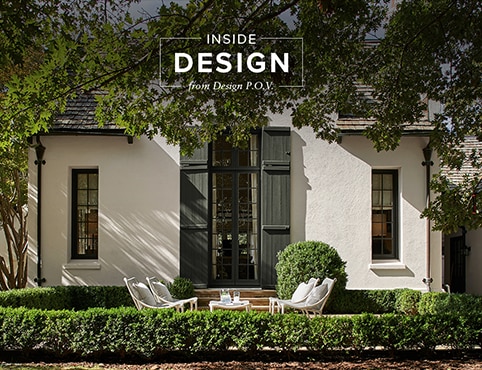Understanding Interior Lighting
Drake/Anderson Explore Creative OptionsRead What Jamie Drake and Caleb Anderson Have to Say:
Jamie Drake and Caleb Anderson, co-principals at New York-based interior design firm Drake/Anderson, delve into understanding interior lighting.
“Lighting today has become very complex and we often work with lighting designers on our projects,” says Anderson.
Drake adds “There's so many technical issues. And in fact, something as simple as a bulb, isn't called a bulb. It's called a lamp and a fixture. A table lamp is not a fixture, it's a luminaire.”
“And LEDs that will give the right kind of light–and light is also a very complex and technical issue–there are lumens. It isn't about wattage any longer. It's not the days of an Edison light bulb anymore. There are so many options with LEDs and halogens. The lumen is actually the terminology that describes the output, the brightness–what we think of as the wattage.”
“Then there are Kelvins. Kelvin is a measurement we use to judge color temperature, confusingly, the higher the number, the cooler the temperature. In residential design we look at 2,700 Kelvins as the gold standard or the golden sunshine standard, something that's warm and embracing and enhancing. But there are places where you might choose to use a higher temperature, a Kelvin number with a cooler output, a brighter output, such as what you might want in a bathroom.”
“We are working with a client we've had for decades on our client roster, and now she suffers from macular degeneration and she's asked for increased lighting in her bathroom so she can see better. And that means not just higher lumens or wattage, but it means a higher Kelvin temperature so that it's brighter. With normal vision, one would probably find this level of bright not very appealing.”
How to Choose the Right Lighting for Each Room
Anderson shares “it's important to take into consideration that different rooms require different types of light. For bathrooms, for example, you need to choose a quality of light and a fixture that's going to illuminate facial features from the front and not from above so as to avoid harsh shadows.”
In areas such as hallways, lighting can be more dramatic as you don’t spend a lot of time in these transition spaces. “Sometimes it's wonderful to have something that really dazzles you as you move through a space,” Drake suggests.
“Kitchens need clear, strong illumination on all work surfaces,” adds Anderson. “This can be achieved with the recess lighting under cabinet lighting, pendants over an island and decorative fixtures.”
Drake notes that you can “add pendants over an island or over the sink area to give another kind of light and something that's a little special and decorative.”
Anderson underlines how important the finishes in a room can be; metals and reflective surfaces all play a role in how a room is illuminated.
“Often the softest room in the house is the bedroom. And a bedroom has a consideration where you want to make sure that you feel that you're bright in the morning to encourage you to wake up, but more embracing and warmer in the evening to encourage sleep,” counsels Drake. “This means flexibility and dimming systems and the ability to change the light levels and the tone of the light.”
Anderson shares that “the great thing about technology is the ability to preset scenes. So, setting lighting scenes for the morning, for the evening or for a party, are all really useful tools today.”
“We often find that living rooms, dining rooms, and family rooms are equally multi-functional spaces these days,” says Drake. “So you need light that is also adaptable. It may need to be very bright for work and reading, such as in a home office. It may need to be more romantic and dimmer for dining or entertaining. And it may need to be really dimmed for watching a movie properly.”
“With advances in technology today,” notes Anderson, “we're even able to capture things such as circadian rhythm.”
Drake believes that “when it comes to lighting, the most effective rooms have the sources coming from multiple places.”
According to Anderson, “This goes beyond things like recess lighting, chandeliers, decorative fixtures, lamps, wall sconces, and includes components like coves that really accent and highlight the architecture of a room.“
“Of course, color only exists in the presence of light,” counsels Drake. “And so when you're thinking about what colors you are going to choose for your upholstery or wall paint, you need to consider first what lighting you're using, because the different types of lamps, the bulbs that you use and the lumens, the output and the Kelvins, and the color temperature will all affect how that color reads when it's finally applied inside the home interior.”
Anderson shares another important consideration around color temperature; make sure that within a room, in any space, that there is consistency throughout, meaning that the bulbs in the chandelier should have the same color temperature as the bulbs in the adjacent lamps.
When addressing color, Drake shares that “with color, there's black and there's white. And then there's everything in between. Black is a color which results from the complete absence or absorption of visible light. White objects on the other hand, fully reflect and scatter the visible wavelengths of light, and both white and black are achromatic colors.”
“At the end of the day, we're not so far removed from our caveman ancestors. We all want to gather around the fire that gives out warmth and light.”
To which Anderson concludes, “sometimes the simplest lighting solution is the best: candles.”



Inside Design
Explore distinct design topics from the interior designers featured on this page.